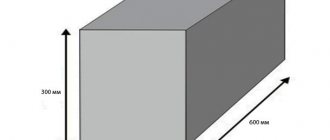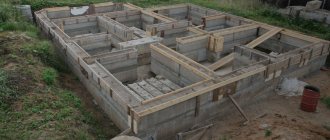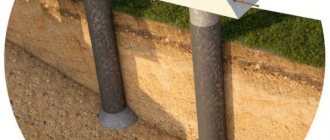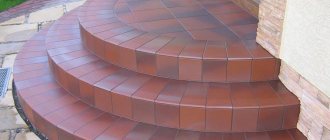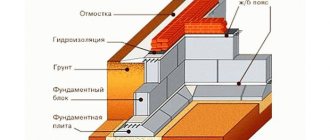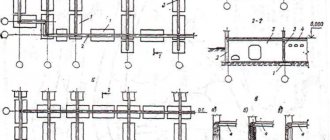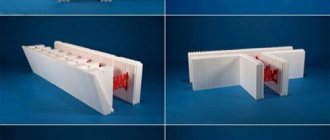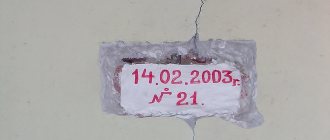The construction of a foundation is a responsible task; it bears all the load from the overlying floors. A prefabricated foundation can be built from foundation blocks; for this you need to purchase high-quality material.
FBS (Foundation Blocks Solid) are used for the construction of foundations and basement walls of various buildings, both residential, industrial or warehouse, as well as for retaining walls, overpasses, bridges, ramps and so on. They are also used as barriers and barriers. In order for FBS foundation blocks to be strong and durable, they must have certain technical characteristics.
The density of the material must be at least 1800 kg/cubic meter, and there must be no voids inside the product. The letter C in the abbreviation means that the blocks are solid. FBS is often deciphered as “foundation wall blocks” or “construction blocks”, this is incorrect.
FBP (hollow, with voids open downwards) and FBV (with cutouts for laying communications) are also produced.
FBS inside can be either reinforced or non-reinforced, the latter option is more common; reinforced products with increased strength can be manufactured to order. FBP is used for the construction of walls; they work as permanent formwork; reinforcement is inserted into the voids and filled with concrete mortar. FBV have cutouts for ease of laying communications, except for this they are the same FBS (they are also solid). They are made to order at concrete factories for specific building projects.
The drawing shows how FBS foundation blocks are constructed.
According to GOST 13579-78, all these types of concrete blocks are used for the construction of basement and underground walls; solid types (FBS) can be used for the construction of foundations. Although this is not the main purpose of FBS, foundations made from them are strong and durable when constructed correctly.
During the manufacturing process, FBS is compacted on vibrating tables or using deep vibrators; for casting, special molds are used that allow strict adherence to the geometry of the product. Elements with broken geometry will not be able to form a dense masonry, and seams that are too wide can allow moisture to pass through. To quickly harden and gain strength, concrete is steamed. With this technology, concrete can gain up to 70% strength in a day instead of several weeks. Technology with or without steaming does not affect the quality of the finished product.
Specifications
GOST, which regulates the production and technical characteristics of FBS, provides for blocks of the following sizes:
- length 2380, 1180, as well as additional length 880 mm,
- width 300, 400, 500 and 600 mm,
- height 280 or 580 mm.
There are also small-sized varieties, such as 600*600*600 mm or 400 mm long. Each product is a rectangular parallelipiped with recesses at the ends for denser masonry, filled with mortar during the construction of a wall or foundation, and mounting loops by which they are hooked for movement and installation.
FBS foundation blocks are made of heavy (density 2400 kg/cub.m), silicate (density 2000 kg/cub.m) or expanded clay (density 1800 kg/cub.m) concrete. The strength class of concrete should be
- not less than B7.5 for concrete grade M100,
- not less than B12.5 for concrete grade M150,
- for heavy concrete - from B3.5 (M50) to B15 (M200).
The table in the picture shows data on strength and weight for FBS made of different concrete.
Frost resistance of FBS must be at least 50 freeze-thaw cycles, water resistance - W2.
The type designation indicates its dimensions in decimeters, rounded up. The marking also indicates the type of concrete:
- "T" - heavy concrete,
- “P” - expanded clay (on porous fillers),
- "C" - silicate.
Let's give an example. FBS-24-4-6 t is a concrete block with dimensions of 2380*400*580 mm, consisting of heavy concrete. It can be marked in another way:
- 24-4-6 t,
- 24.4.6 t,
- 24 4 6 t.
The mass of the blocks is 260 kg or more, so special equipment is needed to build a foundation from them. In residential construction, blocks with a thickness of 60 cm are most often used. The weight of a 24-6-6 block (2380 * 60 * 58 mm, one of the most popular) is 1960 kg. The table in the figure shows the dimensions and masses of FBS. The size deviation in length should be within 13 mm, in width and height - 8 mm, in cutout size - 5 mm.
Important! Please check weight and size before purchasing. If the weight is less than required when marked “T,” it means that the material has voids inside and is not compacted enough, which will negatively affect the strength. You should not buy such products. Before purchasing, ask the seller to show the certificate of conformity for the product. It is better to buy products from large manufacturers. Handicraft blocks will most likely be made in violation of technology; the result of their use may be unpredictable.
The blocks have mounting steel loops (eyes) that are located on the top surface of the block. For hinges, hot-rolled reinforcement or periodic profiles are used. If necessary, you can order FBS without mounting loops; this is allowed by the standards.
The blocks may have a finished or unfinished surface, meaning they may or may not have decorative materials such as tiles attached to them. This characteristic depends on the specific type of FBS. The surface of the material must be smooth, without deep cracks, only small cracks on the surface with a width of no more than 0.1 mm for heavy and silicate types of concrete and no more than 0.2 mm for expanded clay concrete are allowed.
Preparatory stage
A foundation made of FBS blocks requires a preliminary design. A computer program will be an excellent assistant; if you do not have the skills to use a PC, the masonry is drawn on paper by hand. A detailed description will help to take into account all the nuances of installation and tying the FBS foundation. When drawing up a project, the type of soil, groundwater level, number of storeys of the structure and total loads are taken into account.
Comment! If there are FL foundation slabs in the plan, it is easier to prepare a foundation pit. If FBS blocks are installed directly on the ground, a trench along the perimeter of the building will be sufficient.
Recommended settings:
- The width of the trench exceeds the size of the block foundation by 1 m. This gap will be required for waterproofing, wall insulation, and drainage pipes.
- The first row of FBS supports is maintained within 40 cm.
- The next two rows are reduced to 30 cm.
Having compared the dimensions of the foundation and the FBS blocks themselves, they determine the required quantity, after which they proceed to the purchase of material. The project must take into account the outlet points for utilities to purchase blocks of the appropriate configuration. If you miss this point at the planning stage, you will have to drill holes in the foundation in the future, which will entail additional costs of time, energy and finances.
Advantages of using FBS for the foundation
In some cases, using FBS for the foundation is much more convenient than pouring a monolithic foundation.
- The time is reduced - the poured concrete foundation hardens and gains strength in about 4 weeks.
- Standard sizes make it easy to calculate the required amount of this material.
- There are no costs for additional materials (formwork, reinforcement).
- You can select blocks of the desired size and with the required characteristics.
- Durability - with proper installation, manufacturers promise a service life of more than 100 years.
- FBS do not deform over time.
The disadvantages of such a foundation include the need to use equipment for transporting and installing blocks, this leads to an increase in the price of the foundation.
Forming the sole
There are two ways to make a foundation from blocks. It’s easier to go with the sand cushion option. If the ground is unstable, a concrete support is chosen, but this significantly increases time, money and labor costs. Before the stage of forming a compacted sand cushion, the manual for constructing a structure from FBS contains the same points. The process of constructing a foundation on a concrete base starts with the installation of formwork and the installation of a reinforcement cage.
For work you will need sand, crushed stone of 20-40 fractions and reinforcement. Main stages of arrangement:
- The bottom and side surfaces of the pit are leveled.
- The pit for the FBS foundation is covered with a layer of sand 10-15 cm thick. The surface is saturated with water and thoroughly compacted.
- A layer of crushed stone 10 cm thick is placed on top of the sand cushion and compacted again.
After this, they move on to the next stage of foundation construction using FBS blocks.
FBS foundation
Block foundations can be built on those soils on which prefabricated strip foundations can be made. It is best if the soil is rocky or coarse sandy. On weaker soil, a concrete reinforcing belt is made after every two rows. Also, the reinforcing belt must be poured onto the bottom of the pit before installing the FBS. The bottom of the pit must be leveled, covered with sand (if the soil is not sandy) and compacted.
On low-heaving soils, an intermittent foundation can be built. This will reduce the amount of material used, and therefore money costs. For such a foundation, voids are left between the blocks, which are filled with earth, compacting it thoroughly.
Important! Such a foundation can only be built on soil with good bearing capacity. It is first necessary to carry out engineering calculations. There should not be more than 70 cm between the blocks. Such a foundation is made for small houses of up to 2 floors made of lightweight materials. If the house is brick, then it is preferable to use hollow bricks.
Also, on weak soils, the first row is laid out not from ordinary FBS, but from special pillow blocks that have a larger width, thus increasing the area of the foundation base.
Gaps of no more than 70 cm are left between the blocks; they are filled with soil, carefully compacted in layers. Ordinary FBS are placed on a row of “pillows”, so that the seams between them fall on the blocks of the bottom row.
It is recommended to buy FBS as long as possible - this way there will be fewer seams in the foundation, therefore, it will be stronger. The video shows the process of building a foundation and basement from FBS.
Typically, blocks with a height of 580 mm are used for foundations; they are more convenient. The weaker the bearing capacity of the soil, the larger blocks it is recommended to use. For clay and loam it is better to take large reinforced concrete products measuring 24-6-6, and for sandy soil - shorter ones 12-6-6. It is optimal to use 4-5 blocks for the length of the wall; based on this, the length of the FBS is selected.
Due to the strength of FBS, walls can be made thicker than the foundation. It is acceptable for the wall to protrude 10 cm on one side or 6 cm on each side.
Features of the construction of a block base
The FBS foundation is quite simple to install. Initially, a reinforced cushion is prepared, then the walls are laid, and the work is completed with waterproofing.
Comment! If necessary, the design is supplemented with an upper armored belt.
An obstacle to the application of the proposed technology may be the lack of lifting equipment. It is possible to replace the crane with a winch, but this practice is impractical due to the significant increase in labor costs. Otherwise, the arrangement process does not pose any problems even for beginners.
In terms of strength and rigidity, a foundation made of FBS blocks is inferior to its monolithic counterparts. Its advantageous aspects are simplicity and speed of construction, lower costs. The block base is optimally suited for sandy soils. If there is soft and crumbly soil, it is better to abandon this idea due to the risk of subsidence of the structure. This can provoke deformation or destruction of the erected structure.
The foundation of a house made of FBS blocks will withstand soil heaving with virtually no consequences. Under similar impacts, a monolithic structure can rupture, and the block element will only bend. The reason for flexibility and mobility is the presence of seams.
Another advantage of FBS products is the ability to build a foundation in any weather conditions. Snow or rain are not an obstacle to the installation process. It is impossible to pour a monolithic structure under such circumstances.
Characteristics and features of FBS foundation blocks
The concrete block for the FBS foundation is a solid monolithic product made of reinforced concrete, having the shape of a parallelepiped. Among other types of blocks, the material has the highest strength and performance characteristics, thanks to which it can be used in the construction of foundations.
FBS blocks have a solid rectangular cross-section and loops that facilitate the process of transportation and installation
FBS is a reliable, stable and durable building material, which is characterized by increased resistance to environmental influences. The strength characteristics of the product are of particular importance, since the elements are the basis for creating the foundation of the building.
The material is manufactured exclusively in factory conditions, since the quality of each product must be strictly controlled using laboratory instruments in accordance with GOST. Foundation blocks can be made from the following materials:
- silicate concrete or expanded clay concrete with a density of at least 1800 kg/m³;
- lightweight high-strength concrete class B100;
- heavy high-strength concrete grade M50-M200.
Concrete is selected based on the operating conditions of the structure being built. This takes into account temperature changes, mechanical loads and humidity levels. Concrete grade M200 has maximum strength. For harsh operating conditions, you can use filler brand M150, and for standard conditions - M100.
Concrete of strength class from B7.5 to B15 is used as the main material for the manufacture of FBS blocks.
In addition to filler concrete, reinforcement made of A1 or A111 steel is used, which improves strength characteristics and reduces the effects of pressure and compression, and plasticizers, which increase the frost resistance of the material.

